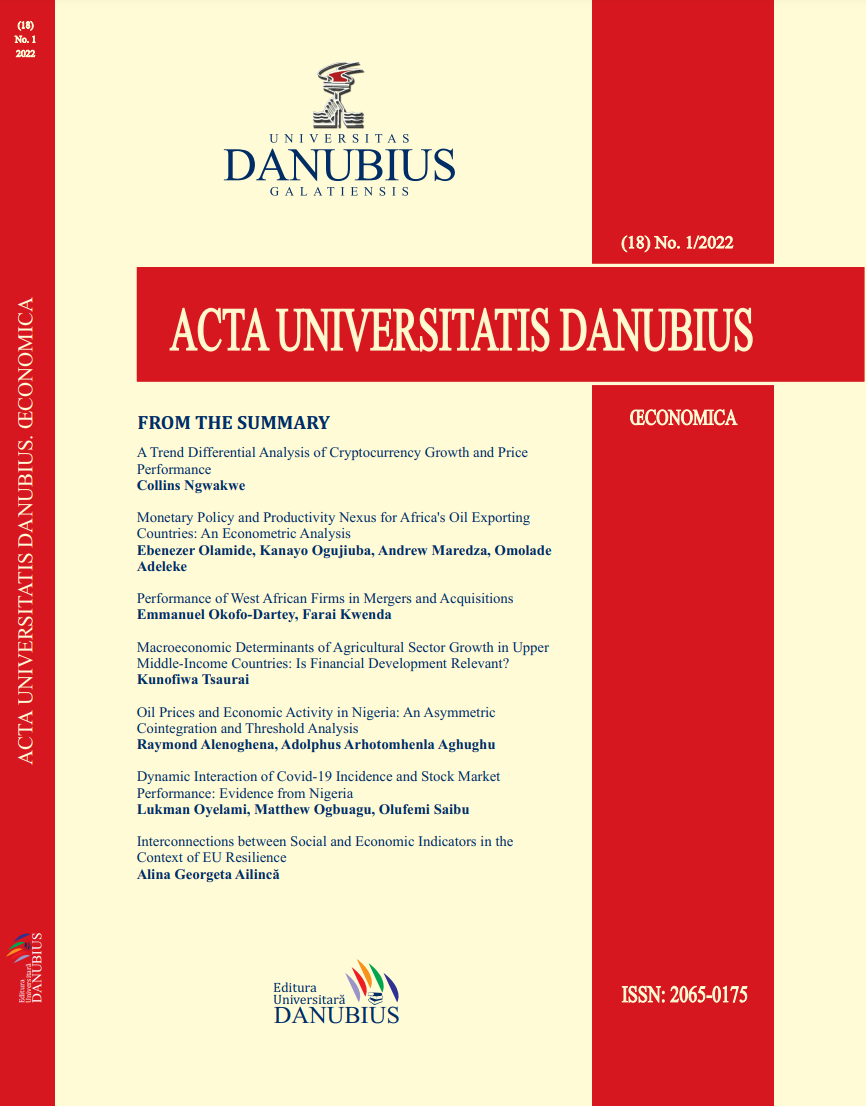Key Pillars for FinTech and Cybersecurity
Keywords:
distributed technology; financial and technology mixture; security; resilienceAbstract
The technological advancements of the last couple of years combined with the unique situation created by the Covid-19 pandemic made the customer more open to the digitalization of several financial services and procedures in order to further reduce the need for face-to-face interaction. The financial technology companies found themselves in the position to leverage advancements in fields such as data analytics and artificial intelligence as well as the new financial paradigm brought by blockchain technology thus making technological innovation a top priority to meet these new customer needs. As the tendency of the financial sector as a whole to further embrace digitalization becomes more apparent, so does the protection of customer data become more complex as cyber-attack vectors increase in complexity aided by an ever-expanding attack surface. We argue that the rapid pace in which technological advancements are adopted in the financial services sector must be accompanied by responsible cyber security policies and regulations enforced from both the technological and human standpoints. We will provide an overview on the pace in which cybercrime in the financial sector grew in intensity as FinTech moved towards an end-to-end approach, the most common cyber threats which affect the financial sector as well as why cyber threat management should not be limited to a reactionary approach.
References
Arner, Douglas W., Barberis, Janos Nathan & Buckley, Ross P. (2015). The Evolution of Fintech: A New Post-Crisis Paradigm?. University of Hong Kong Faculty of Law. Research Paper No. 2015/047, UNSW Law Research Paper No. 2016-62, Available at SSRN: https://ssrn.com/abstract=2676553 or http://dx.doi.org/10.2139/ssrn.2676553.
Badea, L, Rangu, M. C. & Șcheau, M. C. (2021). Considerations on Digital Financial Ecosystem. Conference: 23rd RSEP International Economics, Finance & Business Conference. University of Washington Rome Center. Retrieved from https://www.researchgate.net/publication/356832084_Considerations_on_Digital_Financial_Ecosystem_nov_2021.
Baur-Yazbeck, S., Frickenstein. J & Medine, D. (2019) Cyber Security in Financial Sector Development - Challenges and potential solutions for financial inclusion. Consultative Group tiAssist the Poor (CGAP) & Gesellschaft fur Internationale Zusammenarbeit on behalf of Federal Ministry of Economic Cooperation and Development, Retrieved from https://www.findevgateway.org/sites/default/files/publications/files/cyber_security_paper_november2019.pdf.
Deloitte. (2015). 2016 Hot topics for IT internal audit in financial services. Web page. Retrieved from https://www2.deloitte.com/content/dam/Deloitte/uk/Documents/financial-services/deloitte-uk-audit-on-the-horizon.pdf.
Entrust (2015). 3 Ways Financial Institutions Can Improve Fraud Detection. Web page. Retrieved from https://www.entrust.com/blog/2015/09/3-ways-financial-institutions-can-improve-fraud-detection/.
Estelle M. P & Derek S. P (1994)How To Get A Phd: A Handbook For Students And Their Supervisors. Open University Press; 6th edition (1 Aug. 2015)
European Commission. (2019). Digital Economy and Society Index (DESI). Web page. Retrieved from https://digital-strategy.ec.europa.eu/en/library/digital-economy-and-society-index-desi-2019, date: 20.01.2022.
European Commission. (2020). New Europol report on latest developments of COVID-19 on the criminal landscape in the EU. Web page. Retrieved from https://digital-strategy.ec.europa.eu/en/news/new-europol-report-latest-developments-covid-19-criminal-landscape-eu, date: 18.01.2022
European Commission. (2021a). A cybersecure digital transformation in a complex threat environment — Brochure. Web page. Retrieved from https://digital-strategy.ec.europa.eu/en/library/cybersecure-digital-transformation-complex-threat-environment-brochure, date: 22.12.2021.
European Commission. (2021b). Digital Economy and Society Index (DESI). Web page. Retrieved from https://digital-strategy.ec.europa.eu/en/policies/desi, date: 22.01.2022.
European Commission. (2021c). Proposal for a Regulation laying down harmonised rules on artificial intelligence, Laying down harmonised rules on artificial intelligence (artificial intelligence act) and amending certain union legislative acts. Web page. Retrieved from https://eur-lex.europa.eu/resource.html?uri=cellar:e0649735-a372-11eb-9585-01aa75ed71a1.0001.02/DOC_1&format=PDF.
European Parlament. (2021a). Web page. Retrieved from https://www.europarl.europa.eu/news/en/headlines/priorities/digital, date: 28.01.2022.
European Parliament. (2021b). Web page. Retrieved from https://www.europarl.europa.eu/news/en/press-room/20210604IPR05531/parliament-calls-for-beefed-up-eu-security-against-cyber-threats, date: 28.01.2022.
European Parliament. (2021c). MEPs demand common EU cyber defensive capabilities. Web page. Retrieved from https://www.europarl.europa.eu/news/en/press-room/20210930IPR13930/meps-demand-common-eu-cyber-defensive-capabilitiesats, date: 20.12.2021.
European Parliament. (2022). Web page. Retrieved from https://www.europarl.europa.eu/news/en/headlines/priorities/eu-response-to-coronavirus, date: 28.01.2022.
Lațici, T. (2019). Cyber: How big is the threat?. European Parliamentary Research Service, Web page. Retrieved from https://www.europarl.europa.eu/RegData/etudes/ATAG/2019/637980/EPRS_ATA(2019)637980_EN.pdf.
Maurer, T. & Nelson, A. (2019). International Strategy to Better Protect the Global Financial System against Cyber Threats. Carnegie Endowment for International Peace. Retrieved from https://carnegieendowment.org/files/Maurer_Nelson_FinCyber_final1.pdf.
Negreiro, M. (2021). The NIS2 Directive, A high common level of cybersecurity in the EU. European Parliamentary Research Service, Web page. Retrieved from https://www.europarl.europa.eu/RegData/etudes/BRIE/2021/689333/EPRS_BRI(2021)689333_EN.pdf.
Ng, A.W. & Kwok, B. K. B. (2017). Emergence of Fintech and cybersecurity in a global financial centre: Strategic approach by a regulator", Journal of Financial Regulation and Compliance, Vol. 25 No. 4, pp. 422-434. Web page. Retrieved from https://doi.org/10.1108/JFRC-01-2017-0013.
Niveditha, V. R., Ananthan, T. V., Amudha, S., Sam, D. & Srinidhi, S. (2020). Detect and Classify Zero Day Malware Efficiently In Big Data Platform. International Journal of Advanced Science and Technology. Vol. 29, No. 4s, (2020), pp. 1947-1954.
Organisation for Economic Co-operation and Development – OECD. (2021). Machine Learning and Big Data in Finance: Opportunities, Challenges, and Implications for Policy Makers. Web page. Retrieved from https://www.oecd.org/finance/financial-markets/Artificial-intelligence-machine-learning-big-data-in-finance.pdf.
Pollari, I. & Ruddenklau, A. (2021). Pulse of Fintech, H1’21. KPMG International. Web page. Retrieved from https://assets.kpmg/content/dam/kpmg/xx/pdf/2021/08/pulse-of-fintech-h1.pdf.
Rowntree, L. (2016). How Biometrics in Fintech Can Bring a Different Angle to Using Biometrics in Advertising. Exchange Wire. Web page. Retrieved from https://sdi.ai/blog/artificial-intelligence-and-cyber-crime/, date: 15.12.2021.
Scheffer, J., Pupillo, L., Griffith, M. K., Blockmans, S. & Renda, A. (2018). Strengthening the EU’s Cyber Defence Capabilities. Report of a CEPS Task Force. Centre for European Policy Studies (CEPS). Web page. Retrieved from https://www.ceps.eu/wp-content/uploads/2018/11/CEPS_TFR%20on%20Cyber%20Defence_1.pdf.
Sentient Digital. (2020). Artificial Intelligence and Cyber Crime: Facing New Threats. Web page. Retrieved from https://sdi.ai/blog/artificial-intelligence-and-cyber-crime/, date: 18.12.2021
Ursula, L. (2021). State of the European Union 2021. European Commission. Web page. Retrieved from https://multimedia.europarl.europa.eu/en/package/state-of-european-union-2021_20101, date: 20.12.2021
Yano, M., Dai, C., Masuda, K. & Kishimoto, Y. (2019). Creation of a Blockchain and a New Ecosystem. Research Institute of Economy. Trade and Industry RIETI Policy Discussion Paper Series 19-P-029. Retrieved from https://www.rieti.go.jp/jp/publications/pdp/19p029.pdf.
Downloads
Published
How to Cite
Issue
Section
License
The author fully assumes the content originality and the holograph signature makes him responsible in case of trial.


